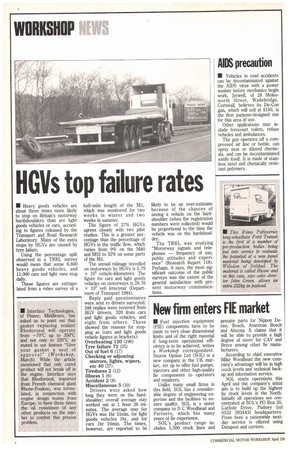HGVs top failure rates
Page 112

If you've noticed an error in this article please click here to report it so we can fix it.
• Heavy goods vehicles are about three times more likely to stop on Britain's motorway hardshoulders than are light goods vehicles or cars, according to figures released by the Transport and Road Research Laboratory. Many of the extra stops by HGVs are caused by tyre failure.
Using the percentage split observed in a TRRL survey would mean that some 6,600 heavy goods vehicles, and 11,000 cars and light vans stop daily.
These figures are extrapolated from a video survey of a half-mile length of the MI, which was monitored for two weeks in winter and two weeks in summer.
The figure of 37% HGVs agrees closely with two pilot studies. This is a greater percentage than the percentage of HGVs in the traffic flow, which varies from 9% on the M40 and M55 to 32% on some parts of the MI.
The annual mileage travelled on motorways by HGVs is 5.79 x 109 vehicle-kilometres. The figure for cars and light goods vehicles on motorways is 28.76 x 109 veh kms/year (Department of Transport 1984).
Reply paid questionnaires were sent to drivers surveyed; 248 replies were received from HGV drivers, 320 from cars and light goods vehicles, and eight from others. These showed the reasons for stopping as (cars and light goods vehicle figures in brackets): Overheating 120 (196) Tyre failure 72 (25) Out of fuel 6 (17) Checking or adjusting mirrors, lights, wipers, etc 40 (37) Tiredness 2 (12) Illness 1 (6) Accident 2 (8) Miscellaneous 5 (19) Drivers were asked how long they were on the hardshoulder, overall average stay worked out at 1 hour 26 minutes. The average stay for HGVs was lhr 51min, for light goods vehicles lhr, and for cars lhr 10min. The times, however, are reported to be likely to be an over-estimate because of the chances of seeing a vehicle on the hardshoulder (when the registration numbers were collected) would be proportional to the time the vehicle was on the hardshoulder.
The TRRL was studying "Motorway signals and telephones — frequency of use, public attitudes and experience" (Research Report 118). Perhaps, it says, the most significant outcome of the public surveys was the extent of the general satisfaction with present motorway communications.
















































































































































